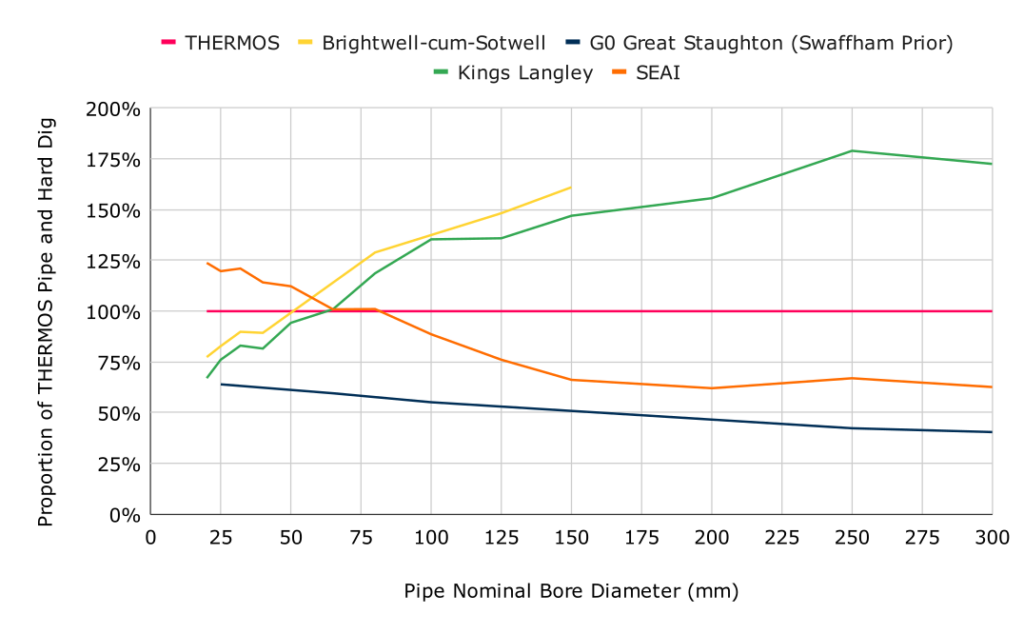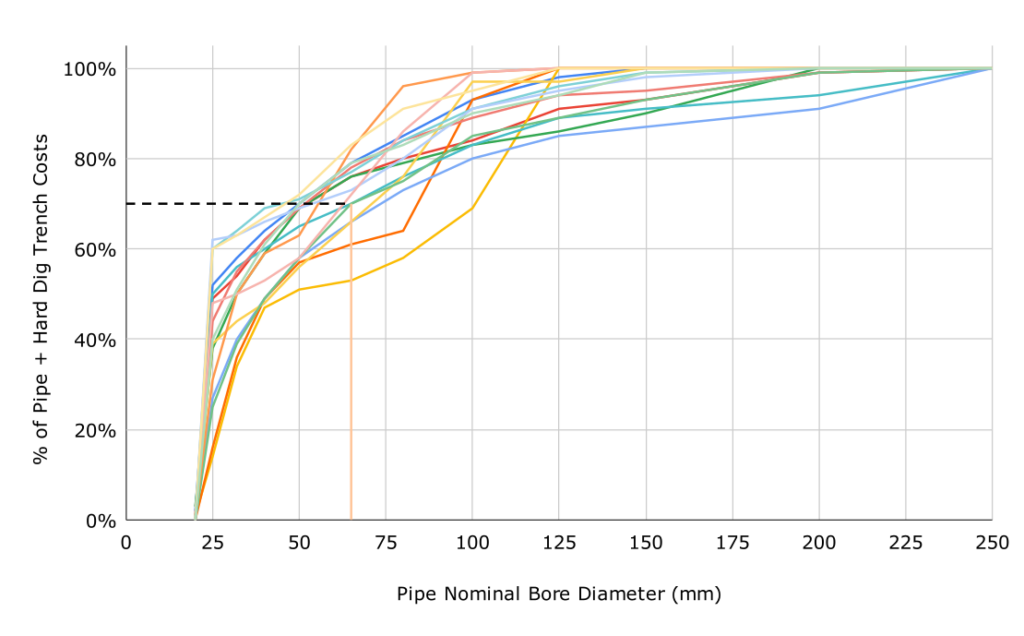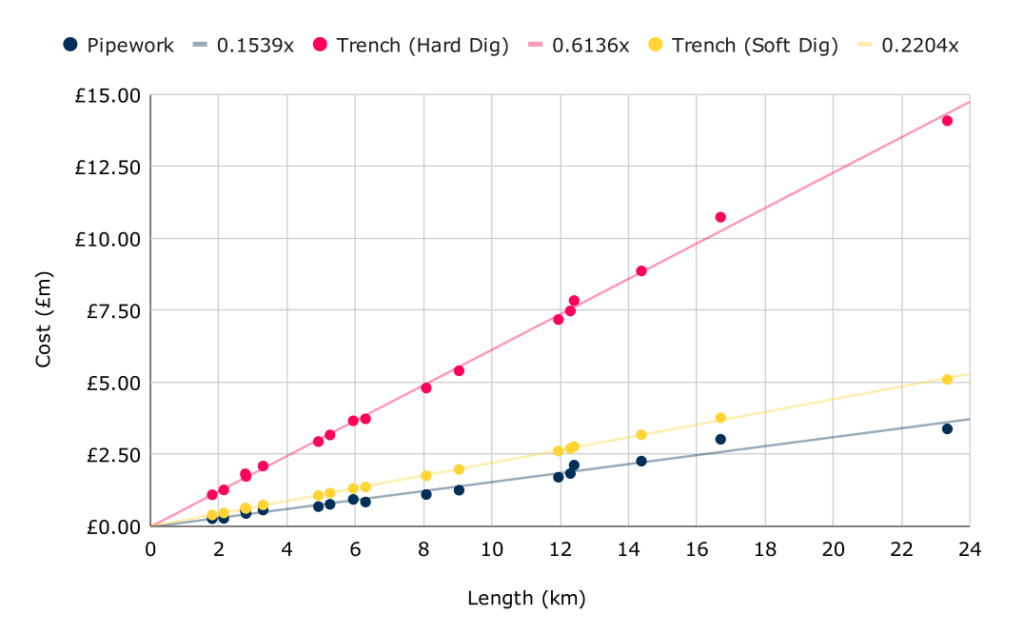Introduction
The pipework used to transfer heat across a network makes up a significant proportion of the capital expenditure of a heat network project however there is little publicly available information on how to estimate pipework costs without details of specific pipework layouts and connected buildings. The main factors which influence the cost of purchasing and installing pipework are:
- Pipework diameter. Larger diameter pipe is more expensive per metre and requires larger trenches.
- Pipework length. Longer networks need more pipe length, which is more expensive.
- Ground conditions. Generally ground conditions are split into “hard dig” and “soft dig”. Digging up a tarmac road to install pipework is considered hard dig and is likely to be more expensive than digging a trench in a field, an example of soft dig.
This article describes how pipework costs are estimated within the CHDU techno-economic model for a generic district heat network site.
Sources of Pipework Costs
It is difficult to obtain quotes for pipework material and installation costs without details of specific pipework layouts, hence pipework costs have been reviewed from the following publicly available sources:
- THERMOS software in-built costs.
- Brightwell-cum-Sotwell heat network feasibility study.
- G0 Great Staughton heat network feasibility study (based on costs used in Swaffham Prior feasibility studies).
- Kings Langley heat network feasibility study.
- Sustainable Energy Authority of Ireland, Inner City costs.
Costs of twin pipe systems of different diameters were extracted from each source along with hard dig trenching costs and inflated to 2024 prices using the Bank of England inflation calculator. A comparison of the combined costs per m of pipework and hard dig trenching operations is presented in Figure 1. Note that the costs from each source have been presented as a percentage of the costs provided in the THERMOS software.

There is a large spread in pipework costs between the different sources with the discrepancy being most pronounced for larger diameter pipework. The comparison suggests that the THERMOS costs are generally larger than other sources up to about 65mm diameter pipe and are approximately the average of the four other sources thereafter.
To investigate the implications of selecting different pipework costs, the distribution of pipework sizes in 16 different THERMOS simulations have been reviewed. The modelled networks connect approximately 70 to 1100 properties delivering heat demands ranging from 2GWh/year to 23GWh/year using up to 23 km of pipework. Figure 2 presents the contribution of different diameter trenched pipes to the overall network pipework cost for each of these 16 networks.

The cumulative distributions of pipework costs indicate that about 70% of the pipework cost is for pipe of 65mm diameter or less. This is as expected within domestic networks where much of the pipework is a branch down a street, or connecting pipework between the network main and individual properties. Considering this distribution alongside Figure 1 suggests that using THERMOS costs is a reasonable decision since THERMOS tends to overestimate the costs of pipework up to ~65mm compared to other sources.
Estimating Network Pipework Costs
The distribution of pipework costs based on pipework size presented in Figure 2 suggest that there can be up to a 40% difference in the distribution of pipework sizes between different networks. Determining the distribution of pipework sizes at a specific network location requires detailed analysis of the specific network layout and connected heat loads which isn’t feasible in the CHDU techno-economic model. Instead, a higher level assessment of pipework costs was completed using outputs from the 16 THERMOS simulations described previously. The total pipework lengths of each of the 16 THERMOS networks were plotted against the costs for pipework, soft dig trenches and hard dig trenches. The relationships are presented in Figure 3.

The relationships between total network length and pipework/trenching costs are very linear despite the different distributions of pipework sizes across the different networks. Trenching costs are consistently larger than pipework costs and hard dig costs are almost 3 times that of soft dig costs.
How Pipework Costs are Modelled
The CHDU techno-economic model uses the THERMOS costs for pipework and trenching. This is because it is expected that ~70% of the pipework in a network primarily connecting to domestic properties is 65mm or smaller, and pipework costs predicted by THERMOS for these diameters are greater than 75% of the reviewed cost sources. Therefore using THERMOS costs are not considered to be overly optimistic.
All pipework is assumed to be installed in hard dig trenches since it is expected that pipework will mostly be installed in the highway. This is a conservative assumption given that hard dig costs are ~3 times soft dig costs.
Total network pipework costs at a specific location are assessed using the linear relationship between THERMOS pipework and trenching costs and total network length presented in Figure 3. The method for estimating the network length at a site is described in a separate article on this site.
References
THERMOS, https://www.thermos-project.eu/thermos-tool/what-is-thermos/
Bioregional / ICAX / Fairheat, Brightwell-cum-Sotwell Decarbonised Community Heating System, RCEF Stage 1 Final Report, Technical Appendix.
Bioregional / ICAX / Fairheat, Kings Langley Decarbonised Community Heating System, RCEF Stage 1 Final Report, Technical Appendix, https://communications4282.wixsite.com/website-3/project-update-5
Element Energy, South-West Huntingdonshire Heat Network Analysis, Stage 1 Pre-Feasibility Study, Final Report, 8th June 2021.Bank of England Inflation Calculator, https://www.bankofengland.co.uk/monetary-policy/inflation/inflation-calculator